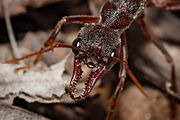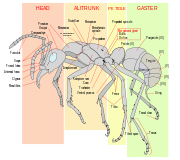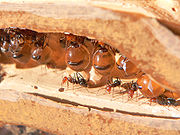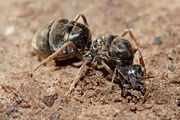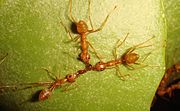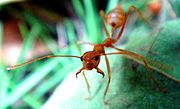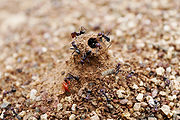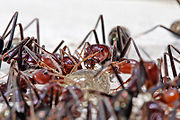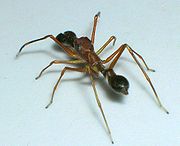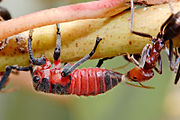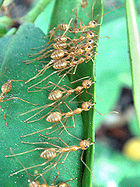
Ant
Background to the schools Wikipedia
SOS Children made this Wikipedia selection alongside other schools resources. Visit the SOS Children website at http://www.soschildren.org/
| Ants Temporal range: Cretaceous - Recent |
||||||||||||||||||||||||||||||||||||||||||||||||||||||||||||||||||||||||||||||||||||||||||||||
|---|---|---|---|---|---|---|---|---|---|---|---|---|---|---|---|---|---|---|---|---|---|---|---|---|---|---|---|---|---|---|---|---|---|---|---|---|---|---|---|---|---|---|---|---|---|---|---|---|---|---|---|---|---|---|---|---|---|---|---|---|---|---|---|---|---|---|---|---|---|---|---|---|---|---|---|---|---|---|---|---|---|---|---|---|---|---|---|---|---|---|---|---|---|---|
 |
||||||||||||||||||||||||||||||||||||||||||||||||||||||||||||||||||||||||||||||||||||||||||||||
| Meat eater ant feeding on honey | ||||||||||||||||||||||||||||||||||||||||||||||||||||||||||||||||||||||||||||||||||||||||||||||
| Scientific classification | ||||||||||||||||||||||||||||||||||||||||||||||||||||||||||||||||||||||||||||||||||||||||||||||
| Kingdom: | Animalia | |||||||||||||||||||||||||||||||||||||||||||||||||||||||||||||||||||||||||||||||||||||||||||||
| Phylum: | Arthropoda | |||||||||||||||||||||||||||||||||||||||||||||||||||||||||||||||||||||||||||||||||||||||||||||
| Class: | Insecta | |||||||||||||||||||||||||||||||||||||||||||||||||||||||||||||||||||||||||||||||||||||||||||||
| Order: | Hymenoptera | |||||||||||||||||||||||||||||||||||||||||||||||||||||||||||||||||||||||||||||||||||||||||||||
| Suborder: | Apocrita | |||||||||||||||||||||||||||||||||||||||||||||||||||||||||||||||||||||||||||||||||||||||||||||
| Superfamily: | Vespoidea | |||||||||||||||||||||||||||||||||||||||||||||||||||||||||||||||||||||||||||||||||||||||||||||
| Family: | Formicidae Latreille, 1809 |
|||||||||||||||||||||||||||||||||||||||||||||||||||||||||||||||||||||||||||||||||||||||||||||
| Subfamilies | ||||||||||||||||||||||||||||||||||||||||||||||||||||||||||||||||||||||||||||||||||||||||||||||
Cladogram of ant subfamilies
A phylogeny of the extant ant subfamilies. |
||||||||||||||||||||||||||||||||||||||||||||||||||||||||||||||||||||||||||||||||||||||||||||||
Ants are social insects of the family Formicidae and, along with the related families of wasps and bees, belong to the order Hymenoptera. Ants evolved from wasp-like ancestors in the mid-Cretaceous period between 110 and 130 million years ago and diversified after the rise of flowering plants. Today, more than 12,000 species are classified with upper estimates of about 14,000 species. They are easily identified by their elbowed antennae and a distinctive node-like structure that forms a slender waist.
Ants form colonies that range in size from a few tens of predatory individuals living in small natural cavities to highly organised colonies which may occupy large territories and consist of millions of individuals that are mostly sterile females forming castes of "workers", "soldiers", or other specialised groups. Ant colonies also have some fertile males called "drones" and one or more fertile females called "queens". The colonies are sometimes described as superorganisms because ants appear to operate as a unified entity, collectively working together to support the colony.
Ants have colonised almost every landmass on Earth. The only places lacking indigenous ants are remote or inhospitable islands. Ants dominate most ecosystems, and form 15–20% of the terrestrial animal biomass. Their success has been attributed to their social organisation, ability to modify their habitats, tap resources and defend themselves. Their long co-evolution with other species has led to mimetic, commensal, parasitic and mutualistic relationships.
Ant societies have division of labour, communication between individuals, and an ability to solve complex problems. These parallels with human societies have long been an inspiration and subject of study. Many human cultures make use of ants in cuisine, medication, and rituals. Some species are valued in their role as biological pest control agents. However, their ability to exploit resources brings ants into conflict with humans, as they can damage crops and invade buildings. Some species, such as the red imported fire ant, are regarded as invasive species, since they can spread rapidly into new areas.
Taxonomy and evolution
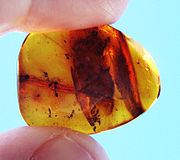
The family Formicidae belongs to the order Hymenoptera, which also includes sawflies, bees and wasps. Ants are evolved from a lineage within the vespoid wasps. Phylogenetic analysis suggests that ants arose in the mid-Cretaceous period about 110 to 130 million years ago. After the rise of flowering plants about 100 million years ago, they diversified and assumed ecological dominance around 60 million years ago. In 1966, E. O. Wilson and his colleagues identified the fossil remains of an ant ( Sphecomyrma freyi) that lived in the Cretaceous period. The specimen, trapped in amber dating back to more than 80 million years ago has features of both ants and wasps.
|
During the Cretaceous period, only a few species of primitive ants ranged widely on the Laurasian super-continent (the northern hemisphere). They were scarce in comparison to other insects, and represented about 1% of the insect population. Ants became dominant after adaptive radiation at the beginning of the Tertiary period. By the Oligocene and Miocene ants had come to represent 20–40% of all insects found in major fossil deposits. Of the species that lived in the Eocene epoch, one of approximately ten genera survive to the present. Genera surviving today comprise 56% of the genera in Baltic amber fossils (early Oligocene), and 92% of the genera in Dominican amber fossils (apparently early Miocene).
Termites, though sometimes called white ants, are unrelated to ants and belong to the order Isoptera and resemble ants only in some aspects of their social life. Velvet ants, look like large ants, but are wingless female wasps.
Etymology
The word ant is derived from ante of Middle English which is derived from æmette and emmett of Old English and is related to the Old High German āmeiza from which comes ameise, the German word for ant. The family name Formicidae is derived from the Latin formīca for ant.
Distribution and diversity
| Region | Number of species |
|---|---|
| Neotropics | 2162 |
| Nearctic | 580 |
| Europe | 180 |
| Africa | 2500 |
| Asia | 2080 |
| Melanesia | 275 |
| Australia | 985 |
| Polynesia | 42 |
Ants are found on all continents except Antarctica and only a few large islands such as Greenland, Iceland, parts of Polynesia and the Hawaiian Islands lack native ant species. Ants occupy a wide range of ecological niches, and are able to exploit a wide range of food resources either as direct or indirect herbivores, predators and scavengers. Most species are omnivorous generalists but a few are specialist feeders. Their ecological dominance may be measured by their biomass, and estimates in different environments suggest that they contribute 15–20% (on average and nearly 25% in the tropics) of the total terrestrial animal biomass, which exceeds that of the vertebrates.
Ants range in size from 0.75 to 52 mm (0.030 to 2.0 in). Their colours vary; most are red or black, green is less common, and some tropical species have a metallic lustre. More than 12,000 species are currently known (with upper estimates of about 14,000), with the greatest diversity in the tropics. Taxonomic studies continue to resolve the classification and systematics of ants. Online databases of ant species, including AntBase and the Hymenoptera Name Server, help to keep track of the known and newly described species. The relative ease with which ants can be sampled and studied in ecosystems has made them useful as indicator species in biodiversity studies.
Morphology
Ants are distinct in their morphology from other insects in having elbowed antennae, metapleural glands, and a strong constriction of their second abdominal segment into a node-like petiole. The head, mesosoma and metasoma or gaster are the three distinct body segments. The petiole forms a narrow waist between their mesosoma (thorax plus the first abdominal segment, which is fused to it) and gaster (abdomen less the abdominal segments in the petiole). The petiole can be formed by one or two nodes (the second alone, or the second and third abdominal segments).
Like other insects, ants have an exoskeleton, an external covering that provides a protective casing around the body and a point of attachment for muscles, in contrast to the internal skeletons of humans and other vertebrates. Insects do not have lungs; oxygen and other gases like carbon dioxide pass through their exoskeleton through tiny valves called spiracles. Insects also lack closed blood vessels; instead, they have a long, thin, perforated tube along the top of the body (called the "dorsal aorta") that functions like a heart, and pumps haemolymph towards the head, thus driving the circulation of the internal fluids. The nervous system consists of a ventral nerve cord that runs the length of the body, with several ganglia and branches along the way reaching into the extremities of the appendages.
An ant's head contains many sensory organs. Like most insects, ants have compound eyes made from numerous tiny lenses attached together. Ants' eyes are good for acute movement detection but do not give a high resolution. They also have three small ocelli (simple eyes) on the top of the head that detect light levels and polarisation. Compared to vertebrates, most ants have poor-to-mediocre eyesight and a few subterranean species are completely blind. Some ants such as Australia's bulldog ant, however, have exceptional vision. Two antennae ("feelers") are attached to the head; these organs detect chemicals, air currents and vibrations; they are also used to transmit and receive signals through touch. The head has two strong jaws, the mandibles, used to carry food, manipulate objects, construct nests, and for defence. In some species a small pocket (infrabuccal chamber) inside the mouth stores food, so it can be passed to other ants or their larvae.
All six legs are attached to the mesosoma ("thorax"). A hooked claw at the end of each leg helps ants to climb and hang onto surfaces. Most queens and male ants have wings; queens shed the wings after the nuptial flight, leaving visible stubs, a distinguishing feature of queens. However, wingless queens (ergatoids) and males occur in a few species.
The metasoma (the "abdomen") of the ant houses important internal organs, including those of the reproductive, respiratory (tracheae) and excretory systems. Many species have stingers, used for subduing prey and defending their nests.
Polymorphism
In the colonies of a few ant species, there are physical castes—workers in distinct size-classes, called minor, median, and major workers. Often the larger ants have disproportionately larger heads, and correspondingly stronger mandibles. Such individuals are sometimes called "soldier" ants because their stronger mandibles make them more effective in fighting, although they are still workers and their "duties" typically do not vary greatly from the minor or median workers. In a few species the median workers are absent, creating a sharp divide between the minors and majors. Weaver ants, for example, have a distinct bimodal size distribution. Some other species show continuous variation in the size of workers. The smallest and largest workers in Pheidologeton diversus show nearly a 500–fold difference in their dry-weights. Workers cannot mate; however, because of the haplodiploid sex-determination system in ants, workers of a number of species can lay unfertilised eggs that become fully fertile haploid males. The role of workers may change with their age and in some species, such as honeypot ants, young workers are fed until their gasters are distended, and act as living food storage vessels. These food storage workers are called repletes. This polymorphism in morphology and behaviour of workers was initially thought to be determined by environmental factors such as nutrition and hormones, which led to different developmental paths, however genetic differences between worker castes have been noted in Acromyrmex sp. These polymorphisms are caused by relatively small genetic changes; differences in a single gene of Solenopsis invicta can decide whether the colony will have single or multiple queens. The Australian jack jumper ant (Myrmecia pilosula), has only a single pair of chromosomes (males have just one chromosome as they are haploid), the lowest number known for any animal making it an interesting subject for studies in the genetics and developmental biology of social insects.
Development
The life of an ant starts from an egg. If the egg is fertilised, the progeny will be female ( diploid); if not, it will be male ( haploid). Ants develop by complete metamorphosis with the larval stages passing through a pupal stage before emerging as an adult. The larva is largely immobile and is fed and cared for by workers. Food is given to the larvae by trophallaxis, a process in which an ant regurgitates liquid food held in its crop. This is also how adults share food, stored in the "social stomach", among themselves. Larvae may also be provided with solid food such as trophic eggs, pieces of prey and seeds brought back by foraging workers and may even be transported directly to captured prey in some species. The larvae grow through a series of moults and enter the pupal stage. The pupa has the appendages free and not fused to the body as in a butterfly pupa. The differentiation into queens and workers (which are both female), and different castes of workers (when they exist), is determined by the nutrition the larvae obtain. Larvae and pupae need to be kept at fairly constant temperatures to ensure proper development, and so are often moved around the various brood chambers within the colony.
A new worker spends the first few days of its adult life caring for the queen and young. It then graduates to digging and other nest work, and later to defending the nest and foraging. These changes are sometimes fairly sudden, and define what are called temporal castes. An explanation for the sequence is suggested by the high casualties involved in foraging, making it an acceptable risk only for ants that are older and are likely to die soon of natural causes.
Most ant species have a system in which only the queen and breeding females have the ability to mate. Contrary to popular belief, some ant nests have multiple queens while others can exist without queens. Workers with the ability to reproduce are called "gamergates" and colonies that lack queens are then called gamergate colonies; colonies with queens are said to be queen-right. The winged male ants, called drones, emerge from pupae along with the breeding females (although some species, like army ants, have wingless queens), and do nothing in life except eat and mate. During the short breeding period, the reproductives, excluding the colony queen, are carried outside where other colonies of similar species are doing the same. Then, all the winged breeding ants take flight. Mating occurs in flight and the males die shortly afterwards. Females of some species mate with multiple males. Mated females then seek a suitable place to begin a colony. There, they break off their wings and begin to lay and care for eggs. The females store the sperm they obtain during their nuptial flight to selectively fertilise future eggs. The first workers to hatch are weak and smaller than later workers, but they begin to serve the colony immediately. They enlarge the nest, forage for food and care for the other eggs. This is how new colonies start in most species. Species that have multiple queens may have a queen leaving the nest along with some workers to found a colony at a new site.
Ant colonies can be long-lived. The queens can live for up to 30 years, and workers live from 1 to 3 years. Males, however, are more transitory, and survive only a few weeks. Ant queens are estimated to live 100 times longer than solitary insects of a similar size.
Ants survive the winter in a state of dormancy or inactivity. The forms of inactivity are varied and some temperate species have larvae going into the inactive state ( diapause), while in others, the adults alone pass the winter in a state of reduced activity. Ants are active all year long in the tropics.
Behaviour and ecology
Communication
Ants communicate with each other using pheromones. These chemical signals are more developed in ants than in other hymenopteran groups. Like other insects, ants perceive smells with their long, thin and mobile antennae. The paired antennae provide information about the direction and intensity of scents. Since most ants live on the ground, they use the soil surface to leave pheromone trails that can be followed by other ants. In species that forage in groups, a forager that finds food marks a trail on the way back to the colony; this trail is followed by other ants, these ants then reinforce the trail when they head back with food to the colony. When the food source is exhausted, no new trails are marked by returning ants and the scent slowly dissipates. This behaviour helps ants deal with changes in their environment. For instance, when an established path to a food source is blocked by an obstacle, the foragers leave the path to explore new routes. If an ant is successful, it leaves a new trail marking the shortest route on its return. Successful trails are followed by more ants, reinforcing better routes and gradually finding the best path.
Ants use pheromones for more than just making trails. A crushed ant emits an alarm pheromone that sends nearby ants into an attack frenzy and attracts more ants from further away. Several ant species even use "propaganda pheromones" to confuse enemy ants and make them fight among themselves. Pheromones are produced by a wide range of structures including Dufour's glands, poison glands and glands on the hindgut, pygidium, rectum, sternum and hind tibia. Pheromones are also exchanged mixed with food and passed by trophallaxis, transferring information within the colony. This allows other ants to detect what task group (e.g., foraging or nest maintenance) other colony members belong to. In ant species with queen castes, workers begin to raise new queens in the colony when the dominant queen stops producing a specific pheromone.
Some ants produce sounds by stridulation, using the gaster segments and their mandibles. Sounds may be used to communicate with colony members or with other species.
Defence
Ants attack and defend themselves by biting and in many species, by stinging, often injecting or spraying chemicals like formic acid. Bullet ants ( Paraponera), located in Central and South America, are considered to have the most painful sting of any insect, although it is usually not fatal to humans. This sting is given the highest rating on the Schmidt Sting Pain Index. The sting of Jack jumper ants can be fatal, and an antivenin has been developed. Fire ants, Solenopsis spp., are unique in having a poison sac containing piperidine alkaloids. Their stings are painful and can be dangerous to hypersensitive persons.
Ants of the genus Odontomachus are equipped with mandibles called trap-jaws. This snap-jaw or catapult mechanism involves a large band of muscles that are released by a "trigger". The movement is incredibly fast, with the long mandibles snapping together within 0.13 ms in Odontomachus bauri. This is far faster than any other predatory movement in the animal kingdom. Before the strike, the mandibles open wide and are locked in the open position. The release is triggered by stimulation of sensory hairs on the side of the mandibles. The mandibles allow slow and fine movement for other tasks. Trap-jaws are also seen in some ants of the Dacetini tribe, an example of convergent evolution.
In addition to defence against predators, ants need to protect their colonies from pathogens. Some worker ants maintain the hygiene of the colony and their activities include undertaking or necrophory, the disposal of dead nest-mates. Oleic acid has been identified as the compound released by dead ants that triggers undertaking behaviour in Atta mexicana.
Nests may be protected from physical threats such as flooding and over-heating by elaborate nest architecture. Workers of Cataulacus muticus, an arboreal species that lives in plant hollows, respond to flooding by drinking water inside the nest, and excreting it outside.
Learning
Many animals can learn behaviours by imitation but ants may be the only group apart from mammals where interactive teaching has been observed. A knowledgeable forager of Temnothorax albipennis leads a naive nest-mate to newly discovered food by the excruciatingly slow process of tandem running. The follower obtains knowledge through its leading tutor. Both leader and follower are acutely sensitive to the progress of their partner with the leader slowing down when the follower lags, and speeding up when the follower gets too close.
Controlled experiments with colonies of Cerapachys biroi suggests that individuals may choose nest roles based on their previous experience. An entire generation of identical workers was divided into two groups whose outcome in food foraging was controlled. One group was continually rewarded with prey, while it was made certain that the other failed. As a result, members of the successful group intensified their foraging attempts while the unsuccessful group ventured out less and less. A month later, the successful foragers continued in their role while the others moved to specialise in brood care.
Nest construction
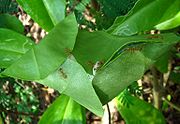
Complex nests are built by many ants, but other species are nomadic and do not build permanent structures. Ants may form subterranean nests or build them on trees. These nests can be found in the ground, under stones or logs, inside logs, hollow stems or even acorns. The materials used for construction include soil and plant matter, and ants carefully select their nest sites; Temnothorax albipennis will avoid sites with dead ants, as these may indicate the presence of pests or disease. They are quick to abandon established nests at the first sign of threats.
The army ants of South America and the driver ants of Africa do not build permanent nests, but instead alternate between nomadism and stages where the workers form a temporary nest ( bivouac) from their own bodies, by holding each other together.
Weaver ant (Oecophylla spp.) workers build nests in trees by attaching leaves together, first pulling them together with bridges of workers and then inducing their larvae to produce silk as they are moved along the leaf edges. Similar forms of nest construction are seen in some species of Polyrhachis.
Food cultivation
Leafcutter ants ( Atta and Acromyrmex) feed exclusively on a fungus that grows only within their colonies. They continually collect leaves which are taken to the colony, cut into tiny pieces and placed in fungal gardens. Workers specialise in tasks according to their sizes. The largest ants cut stalks, smaller workers chew the leaves and the smallest tend the fungus. Leafcutter ants are sensitive enough to recognise the reaction of the fungus to different plant material, apparently detecting chemical signals from the fungus. If a particular type of leaf is toxic to the fungus the colony will no longer collect it. The ants feed on structures produced by the fungi called gongylidia. Symbiotic bacteria on the exterior surface of the ants produce antibiotics that kill bacteria that may harm the fungi.
Foraging ants travel distances of up to 200 metres (660 ft) from their nest and usually find their way back using scent trails. Some ants forage at night. Day foraging ants in hot and arid regions face death by desiccation, so the ability to find the shortest route back to the nest reduces that risk. Diurnal desert ants (Cataglyphis fortis) use visual landmarks in combination with other cues to navigate. In the absence of visual landmarks, the closely related Sahara desert ant (Cataglyphis bicolor) navigates by keeping track of direction as well as distance travelled, like an internal pedometer that counts how many steps they take in each direction. They integrate this information to find the shortest route back to their nest. Several species of ants are able to use the Earth's magnetic field. Ants' compound eyes have specialised cells that detect polarised light from the Sun, which is used to determine direction.
Locomotion
Worker ants do not have wings and reproductive females lose their wings after their mating flights in order to begin their colonies. Therefore, unlike their wasp ancestors, most ants travel by walking. Some species are capable of leaping. For example, Jerdon's jumping ant ( Harpegnathos saltator) is able to jump by synchronising the action of its mid and hind pairs of legs. There are several species of gliding ant including Cephalotes atratus; this may be a common trait among most arboreal ants. Ants with this ability are able to control the direction of their descent while falling.
Other species of ants can form chains to bridge gaps over water, underground, or through spaces in vegetation. Some species also form floating rafts that help them survive floods. These rafts may also have a role in allowing ants to colonise islands. Polyrhachis sokolova, a species of ant found in Australian mangrove swamps, can swim and live in underwater nests. Since they lack gills, they breathe in trapped pockets of air in the submerged nests.
Cooperation and competition
Not all ants have the same kind of societies. The Australian bulldog ants are among the biggest and most basal (primitive) of ants. Like virtually all ants they are eusocial, but their social behaviour is poorly developed compared to other species. Each individual hunts alone, using its large eyes instead of its chemical senses to find prey.
Some species (such as Tetramorium caespitum) attack and take over neighbouring ant colonies. Others are less expansionist but just as aggressive; they invade colonies to steal eggs or larvae, which they either eat or raise as workers/slaves. Extreme specialists among these slave-raiding ants, such as the Amazon ants, are incapable of feeding themselves and need captured workers to survive.
Ants identify kin and nestmates through their scent, which comes from hydrocarbon-laced secretions that coat their exoskeletons. If an ant is separated from its original colony, it will eventually lose the colony scent. Any ant that enters a colony without a matching scent will be attacked.
Parasitic ant species enter the colonies of host ants and establish themselves as social parasites; species like Strumigenys xenos are entirely parasitic and do not have workers, but instead rely on the food gathered by their Strumigenys perplexa hosts. This form of parasitism is seen across many ant genera, but the parasitic ant is usually a species that is closely-related to its host. A variety of methods are employed to enter the nest of the host ant. A parasitic queen can enter the host nest before the first brood has hatched, establishing herself prior to development of a colony scent. Other species use pheromones to confuse the host ants or to trick them into carrying the parasitic queen into the nest. Some simply fight their way into the nest.
Relationships with other organisms
Ants form symbiotic associations with a range of species, including other ant species, insects, plants, and fungi. They are preyed on by many animals and even certain fungi. Some arthropod species spend part of their lives within ant nests, either preying on ants, their larvae and eggs, consuming the ants' food stores, or avoiding predators. These inquilines can bear a close resemblance to ants. The nature of this ant mimicry (myrmecomorphy) varies, with some cases involving Batesian mimicry, where the mimic reduces the risk of predation. Others show Wasmannian mimicry, a form of mimicry seen only in inquilines.
Aphids and other hemipteran insects secrete a sweet liquid called honeydew when they feed on plant sap. The sugars in honeydew are a high-energy food source, which many ant species collect. In some cases the aphids secrete the honeydew in response to the ants' tapping them with their antennae. The ants in turn keep predators away and will move the aphids between feeding locations. On migrating to a new area, many colonies will take the aphids with them, to ensure a continued supply of honeydew. Ants also tend mealybugs to harvest their honeydew. Mealybugs can become a serious pest of pineapples if ants are present to protect mealybugs from their natural enemies.
Myrmecophilous (ant-loving) caterpillars of the family Lycaenidae (e.g., blues, coppers, or hairstreaks) are herded by the ants, led to feeding areas in the daytime, and brought inside the ants' nest at night. The caterpillars have a gland which secretes honeydew when the ants massage them. Some caterpillars produce vibrations and sounds that are perceived by the ants. Other caterpillars have evolved from ant-loving to ant-eating: these myrmecophagous caterpillars secrete a pheromone that makes the ants act as if the caterpillar is one of their own larvae. The caterpillar is then taken into the ants' nest where it feeds on the ant larvae.
Fungus-growing ants that make up the tribe Attini, including leafcutter ants, cultivate certain species of fungus in the Leucoagaricus or Leucocoprinus genera of the Agaricaceae family. In this ant-fungus mutualism, both species depend on each other for survival. The ant Allomerus decemarticulatus has evolved a three-way association with the host plant Hirtella physophora (Chrysobalanaceae), and a sticky fungus which is used to trap their insect prey.

Lemon ants make devil's gardens by killing surrounding plants with their stings and leaving a pure patch of lemon ant trees (Duroia hirsuta). This modification of the forest provides the ants with more nesting sites inside the stems of the Duroia trees. Some trees have extrafloral nectaries that provide food for ants, which in turn protect the plant from herbivorous insects. Species like the bullhorn acacia ( Acacia cornigera) in Central America have hollow thorns that house colonies of stinging ants ( Pseudomyrmex ferruginea) that defend the tree against insects, browsing mammals, and epiphytic vines. Isotopic labeling studies suggest that plants also obtain nitrogen from the symbiotic ants. In return, the ants obtain food from protein-lipid Beltian bodies. Another example of this type of ectosymbiosis comes from the Macaranga tree, which has stems adapted to house colonies of Crematogaster ants.
Many tropical tree species have seeds that are dispersed by ants. Seed dispersal by ants or myrmecochory is widespread particularly in Africa and Australia. Some plants in fire-prone grassland systems are particularly dependent on ants for their survival and dispersal. Many ant-dispersed seeds have special external structures, elaiosomes, that are sought after by ants as food. A convergence, possibly a form of mimicry, is seen in the eggs of stick insects. They have an edible elaiosome-like structure and are taken into the ant nest where the young hatch.
Flies in the Old World genus Bengalia ( Calliphoridae) prey on ants and are kleptoparasites, snatching prey or brood from the mandibles of adult ants. Wingless and legless females of the Malaysian phorid fly ( Vestigipoda myrmolarvoidea) live in the nests of ants of the genus Aenictus and are cared for by the ants.
The fungus Cordyceps infects ants, causing them to climb up plants and sink their mandibles into plant tissue. The fungus kills the ant, grows on its remains, and produces a fruiting body. It appears that the fungus alters the behaviour of the ant to help disperse its spores. Strepsipteran parasites also manipulate their ant host to climb grass stems, to help the parasite find mates. A nematode (Myrmeconema neotropicum) that infects canopy ants ( Cephalotes atratus) causes the black coloured gasters of workers to turn red. The parasite also alters the behaviour of the ant, and makes them carry their gasters high. The conspicuous red gasters are mistaken by birds for ripe fruits such as Hyeronima alchorneoides and eaten. The droppings of the bird are collected by other ants and fed to their young leading to the further spread of the nematode.
South American poison dart frogs in the genus Dendrobates feed mainly on ants, and the toxins in their skin may come from the ants. Several South American antbirds follow army ants to feed on the insects that are flushed from cover by the foraging ants. This behaviour was once considered mutualistic, but later studies show that it is instead kleptoparastic, with the birds stealing prey. Birds indulge in a peculiar behaviour called anting that is as yet not fully understood. Here birds rest on ant nests, or pick and drop ants onto their wings and feathers; this may remove ectoparasites. Anteaters, pangolins and several marsupial species in Australia have special adaptations for living on a diet of ants. These adaptations include long, sticky tongues to capture ants and strong claws to break into ant nests. Brown bears (Ursus arctos) have been found to feed on ants, and about 12%, 16%, and 4% of their faecal volume in spring, summer, and autumn, respectively, is composed of ants.
Relationship with humans
Ants perform many ecological roles that are beneficial to humans, including the suppression of pest populations and aeration of the soil. The use of weaver ants in citrus cultivation in southern China is considered one of the oldest known applications of biological control. On the other hand, ants can become nuisances when they invade buildings, or cause economic losses.
In some parts of the world, large ants, especially army ants, are used as sutures. The wound is pressed together and ants are applied along it. The ant seizes the edges of the wound in its mandibles and locks in place. The body is then cut off and the head and mandibles remain in place to close the wound.
Some ants of the family Ponerinae have toxic venom and are of medical importance. The species include Paraponera clavata (Tocandira) and Dinoponera spp. (false Tocandiras) of South America and the Myrmecia ants of Australia.
In South Africa, ants are used to help harvest rooibos (Aspalathus linearis), which are small seeds used to make a herbal tea. The plant disperses its seeds widely, making manual collection difficult. Black ants collect and store these and other seeds in their nest, where humans can gather them en masse. Up to half a pound of seeds can be collected from one ant-heap.
As food
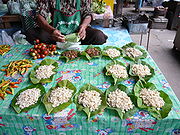
Ants and their larvae are eaten in different parts of the world. The eggs of two species of ants are the basis for the dish in Mexico known as escamoles. They are considered a form of insect caviar and can sell for as much as 40 USD per pound because they are seasonal and hard to find. In the Colombian department of Santander, hormigas culonas (Spanish for "fatass ants") Atta laevigata are toasted alive and eaten.
In areas of India, and throughout Burma and Thailand, a paste of the green weaver ant ( Oecophylla smaragdina) is served as a condiment with curry. Weaver ant eggs and larvae as well as the ants themselves may be used in a Thai salad, yum (ยำ), in a dish called yum khai mod daeng (ยำไข่มดแดง) or red ant egg salad, a dish that comes from the Issan or north-eastern region of Thailand. Saville-Kent, in the Naturalist in Australia wrote "Beauty, in the case of the green ant, is more than skin-deep. Their attractive, almost sweetmeat-like translucency possibly invited the first essays at their consumption by the human species". Mashed up in water, after the manner of lemon squash, "these ants form a pleasant acid drink which is held in high favour by the natives of North Queensland, and is even appreciated by many European palates".
In his First Summer in the Sierra, John Muir notes that the Digger Indians of California ate the tickly acid gasters of the large jet-black carpenter ants. The Mexican Indians eat the replete workers, or living honey-pots, of the honey ant ( Myrmecocystus).
As pests
Some ant species are considered pests, and because of the adaptive nature of ant colonies, eliminating the entire colony is nearly impossible. Pest management is therefore a matter of controlling local populations, instead of eliminating an entire colony, and most attempts at control are temporary solutions.
Ants classified as pests include pavement ants, yellow crazy ants, sugar ants, Pharaoh ants, carpenter ants, Argentine ants, and red imported fire ants. Populations are controlled using insecticide baits, either in granule or liquid formulations. Bait is gathered by the ants as food and brought back to the nest where the poison is inadvertently spread to other colony members through trophallaxis. Boric acid and borax are often used as insecticides that are relatively safe for humans. Bait may be broadcast over a large area to control species like the red fire ant that occupy large areas. Nests of red fire ants may be destroyed by following the ants' trails back to the nest and then pouring boiling water into it to kill the queen. This works in about 60% of the mounds and requires about 14 litres (3 imp gal) per mound.
In science and technology
Myrmecologists study ants in the laboratory and in their natural conditions. Their complex and variable social structures have made ants ideal model organisms. Studies on ants have tested hypotheses in ecology, sociobiology and have been particularly important in examining the predictions of theories of kin selection and evolutionarily stable strategies. Ant colonies can be studied by rearing or temporarily maintaining them in formicaria, specially constructed glass framed enclosures. Individuals may be tracked for study by marking them with colours.
The successful techniques used by ant colonies have been studied in computer science and robotics to produce distributed and fault-tolerant systems for solving problems. This area of biomimetics has led to studies of ant locomotion, search engines that make use of "foraging trails", fault-tolerant storage and networking algorithms.
In culture
Ants have often been used in fables and children's stories to represent industriousness and cooperative effort. They are also mentioned in religious texts. In the Book of Proverbs in the Bible, ants are held up as a good example for humans for their hard work and cooperation. Aesop did the same in his fable "The Grasshopper and the Ants". In parts of Africa, ants are considered to be the messengers of the gods. Ant bites are often said to have curative properties. The sting of some species of Pseudomyrmex is claimed to give fever relief. Some Native American mythology, such as the Hopi mythology, consider ants as the very first animals. Others use ant bites in initiation ceremonies as a test of endurance.
The Japanese word for ant, ari, is represented by an ideograph formed of the character for insect combined with the character signifying moral rectitude, propriety (giri). So the Japanese character could possibly be read as The Propriety-Insect.
Ant society has always fascinated humans and has been written about both humorously and seriously. Mark Twain wrote about ants in his A Tramp Abroad. Some modern authors have used the example of the ants to comment on the relationship between society and the individual. Examples are Robert Frost in his poem "Departmental" and T. H. White in his fantasy novel The Once and Future King. The plot in French entomologist and writer Bernard Werber's science-fiction novel Les Fourmis is divided between the worlds of ants and humans, ants and their behaviour is described using contemporary scientific knowledge. In more recent times, animated cartoons and 3D animated movies featuring ants have been produced include Antz, A Bug's Life, The Ant Bully, The Ant and the Aardvark, Atom Ant, and there is a comic book superhero called Ant-Man.
From the late 1950s through the late 1970s, ant farms were popular educational children's toys in the United States. In the early 1990s, the video game SimAnt, which simulated an ant colony, won the 1992 Codie award for "Best Simulation Program".
Ants are also quite popular inspiration for many science-fiction creatures, such as the Formics of Ender's Game, the Bugs of Starship Troopers, and the giant ants in the film Them!. In strategy games, ant-based species often benefit from increased production rates due to their single-minded focus, such as the Klackons in the Master of Orion series of games or the ChCht in Deadlock II. These characters are often credited with a hive mind, a common misconception about ant colonies.

